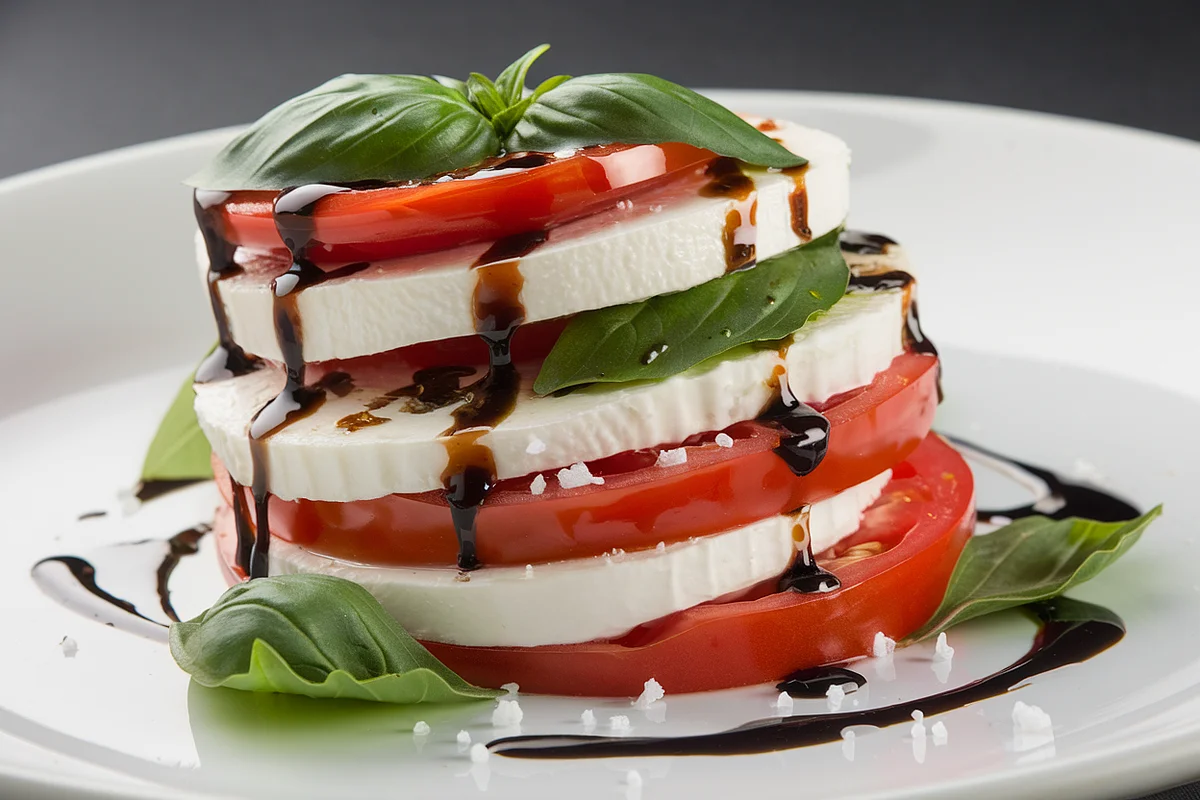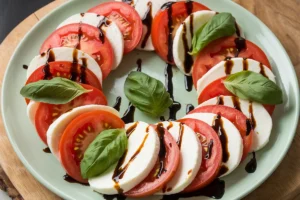Caprese salad, or Insalata Caprese, is one of the simplest yet most elegant dishes from Italian cuisine. With its fresh ingredients and vibrant colors, it perfectly blends taste and beauty. But what exactly goes into making a Caprese salad? In this article, we’ll dive deep into the essential ingredients, history, variations, and health benefits of this classic dish, giving you everything you need to know.
Introduction to Caprese Salad
The classic Caprese salad is more than just a combination of fresh ingredients—it symbolizes Italian culinary tradition. The dish stands out due to its simplicity. It doesn’t rely on complex techniques or spices, but instead on the quality of its core components. Made with fresh mozzarella, ripe tomatoes, basil, and a drizzle of extra virgin olive oil, this salad is refreshing and perfect for any occasion.
Caprese salad has become a staple not only in Italy but also around the world, thanks to its simplicity, health benefits, and versatility. Whether you’re looking for a quick appetizer, a light lunch, or a side dish, Caprese salad fits the bill.
History and Origin of Caprese Salad
Caprese salad originated on the island of Capri, off the coast of Naples, Italy. According to tradition, a patriotic Italian chef after World War I created the dish to represent the colors of the Italian flag: red (tomatoes), white (mozzarella), and green (basil). Since then, it has evolved into a symbol of Italian cuisine worldwide.
Though its roots are in Italy, Caprese salad has spread far beyond the Mediterranean, becoming a favorite in American households and fine dining establishments alike. This traditional Italian dish now boasts countless variations around the globe.
Core Ingredients of Caprese Salad
Caprese salad consists of five essential ingredients: fresh mozzarella cheese, ripe tomatoes, basil, olive oil, and salt and pepper. Each plays a crucial role in shaping the salad’s signature flavor. Let’s break them down:
Fresh Mozzarella Cheese
The heart of any good Caprese salad lies in the fresh mozzarella. Whether you use the traditional bufala mozzarella made from water buffalo milk or the more common fior di latte (made from cow’s milk), the key is to choose mozzarella that is soft, milky, and fresh. The creaminess of the cheese balances out the acidity of the tomatoes, creating a perfect harmony of flavors.
Fresh mozzarella typically comes in balls or logs. When preparing Caprese salad, slicing the mozzarella evenly ensures that every bite has the right balance of ingredients.
Ripe Tomatoes
A close second to mozzarella in importance, tomatoes form the foundation of a great Caprese salad. Typically, heirloom tomatoes or vine-ripened tomatoes offer the best flavor and juiciness.
To get the best flavor, choose plump, ripe, and vibrant tomatoes. The texture should be firm but juicy to complement the creamy mozzarella. For a visually stunning salad, consider using different colored heirloom tomatoes to bring out reds, oranges, yellows, and even purple hues.
Basil Leaves
Fresh basil adds a fragrant element that ties the dish together. Its peppery, slightly sweet flavor provides a contrast to the mild mozzarella and tangy tomatoes. When selecting basil, choose bright green leaves that are firm to the touch.
Fresh basil is essential in Caprese salad. Using dried or wilted basil simply won’t deliver the same flavor or visual appeal. The basil typically sits between the mozzarella and tomatoes, not only adding flavor but completing the dish with a splash of green.
Olive Oil
Olive oil acts as the dressing, bringing all the ingredients together. Extra virgin olive oil works best for its rich, fruity flavor. Drizzle the oil lightly over the salad to enhance the fresh produce without overwhelming it.
Choosing high-quality olive oil is key because it adds depth and richness to the dish. You can find a more detailed guide on the types of olive oil for Caprese salad here.
Salt and Pepper
Though simple, salt and pepper help elevate the flavors of the tomatoes and mozzarella. A sprinkle of sea salt or flaky salt enhances the natural juices of the tomatoes, while freshly cracked black pepper adds a subtle kick.
Experiment with different types of salt, such as Himalayan pink salt or Maldon sea salt, for a unique twist on the traditional dish.
Optional Ingredients and Variations
While the traditional salad relies on its core ingredients, there are countless ways to personalize the dish. Here are some popular options:
- Balsamic Glaze: A drizzle of balsamic reduction introduces a sweet and tangy flavor that contrasts beautifully with the savory elements of the salad. Though not traditional, this addition has become popular in modern variations. Learn more about how to use balsamic glaze in Caprese salad.
- Pesto: Replacing basil leaves with a spoonful of pesto gives the salad a richer, more intense flavor. Fresh pesto made with basil, garlic, pine nuts, and olive oil adds a zesty twist.
- Avocado: Adding avocado slices brings a creamy texture that makes the salad more filling—perfect for a light main course.
- Prosciutto: Thin slices of prosciutto can be layered between the mozzarella and tomatoes for a meaty, savory take on Caprese.
- Pine Nuts: Pine nuts provide a delightful crunch and hint of nuttiness, complementing the soft textures of mozzarella and tomatoes.
How to Make the Perfect Caprese Salad
Making the perfect salad begins with selecting the right ingredients and following a few simple steps:
Step-by-Step Guide
- Choose Fresh Ingredients: The key to a great Caprese salad is fresh, high-quality ingredients. Select ripe tomatoes, soft mozzarella, and vibrant basil leaves.
- Slice Evenly: Slice the tomatoes and mozzarella into even pieces to ensure every bite has a balanced mix of flavors.
- Arrange Elegantly: On a large platter, alternate slices of tomato and mozzarella. Place a basil leaf between each slice for a layered, visually appealing presentation.
- Drizzle Olive Oil: Lightly drizzle extra virgin olive oil over the salad. Avoid using too much—just enough to coat the ingredients.
- Season with Salt and Pepper: Sprinkle sea salt and freshly cracked black pepper to enhance the natural flavors of the tomatoes and cheese.
- Serve Immediately: Caprese tastes best when served fresh. If possible, serve it right after preparation to maintain the texture and flavor.
Presentation Tips
Caprese salad’s appeal lies not just in its flavor but also in its presentation. For a restaurant-worthy look, try these tips:
- Use Different Tomato Varieties: Mix heirloom, cherry, and grape tomatoes for a colorful, visually appealing salad.
- Stack or Skewer: Instead of layering the ingredients flat on a plate, stack them vertically for a unique presentation or skewer them for bite-sized, party-friendly portions.
Caprese Salad Variations Around the World
As Caprese salad gained popularity outside of Italy, chefs and home cooks started experimenting with the traditional recipe. Here are some common variations:
- Caprese Skewers: For a portable, party-friendly option, make Caprese skewers using cherry tomatoes, mini mozzarella balls, and basil leaves.
- Caprese Sandwich: The salad can easily become a Caprese sandwich by layering the ingredients between slices of crusty bread, creating a perfect lunch option.
- Grilled Caprese: In some versions, the tomatoes and mozzarella are grilled before being assembled, adding a smoky flavor that complements the fresh basil and olive oil.
Health Benefits of Caprese Salad
Beyond its delicious taste, salad offers numerous health benefits. Each ingredient provides nutritional value, making it a wholesome, low-calorie dish. Here’s a breakdown of its health benefits:
- Mozzarella: Fresh mozzarella provides protein and calcium, supporting bone health and providing healthy fats that promote satiety.
- Tomatoes: Tomatoes are rich in antioxidants such as lycopene, which may reduce the risk of heart disease and certain cancers. They also contain vitamins A and C, which help promote eye health and boost immunity.
- Basil: Fresh basil offers anti-inflammatory benefits and contains essential oils that fight infections. It also contains vitamins A and K.
- Olive Oil: Extra virgin olive oil, a staple in the Mediterranean diet, is rich in heart-healthy monounsaturated fats and antioxidants, helping lower bad cholesterol and reduce inflammation.
FAQs About Salad
Here are some of the most frequently asked questions about Caprese salad:
- What is Caprese salad made of?
Caprese salad consists of fresh mozzarella cheese, ripe tomatoes, basil, olive oil, salt, and pepper. - What is the best mozzarella for Caprese salad?
The best mozzarella for Caprese salad is buffalo mozzarella due to its creamy texture and rich flavor. However, cow’s milk mozzarella (fior di latte) also works well. - Can I make Caprese salad ahead of time?
Yes, but it’s best to serve it fresh. If you need to prepare it in advance, store the ingredients separately and assemble the salad just before serving to avoid sogginess. - Is Caprese salad healthy?
Absolutely. Caprese salad is low in calories and packed with nutrients, making it a healthy option for any meal. - What wine pairs well with salad?
Light, crisp white wines such as Sauvignon Blanc or Pinot Grigio pair beautifully with salad.
Conclusion
Caprese salad celebrates simplicity and fresh ingredients. With just a few high-quality components, you can create a dish that is not only delicious but also visually appealing. Whether you stick to the traditional recipe or experiment with variations, Caprese salad is a versatile dish perfect for any occasion. Now that you know what goes into making the perfect salad, it’s time to try it yourself!



